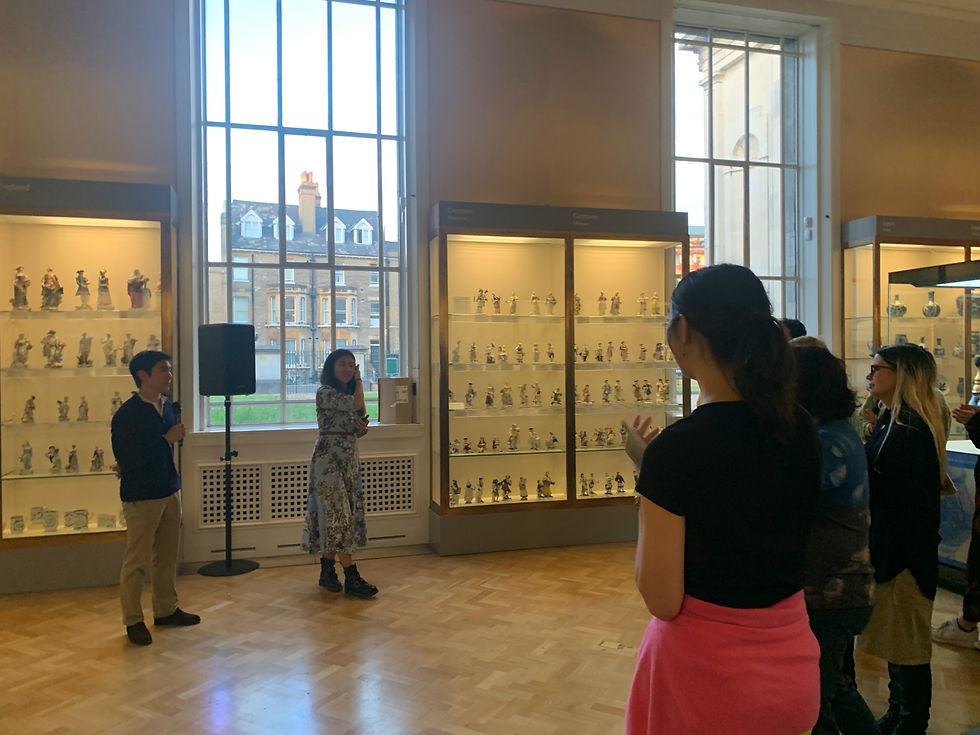Not-Quite-Love After Dark
- caffeine conversations

- May 17, 2024
- 3 min read
Reviewing William Blake Late event, ‘Love After Dark’, at Cambridge’s Fitzwilliam Museum
By Rowan Wolter
What I really wanted from Love Art After Dark was to run around the Fitzwilliam in the dark like a scene out of Night at the Museum, and maybe learn a bit more about William Blake. The event, organised by the Fitzwilliam Museum Society and held on April 30th, offered a night of poetry, music, talks, art, and workshops, focusing on ‘William Blake and Conflict : Beyond Borders and Forms’. The premise was certainly promising. Admittedly, having the exhibits come to life might have been asking a bit much, but I would have liked it to have actually been dark during an ‘After Dark’ event - the sun was still streaming through the windows like it was midday.

As I walked in the doors I was accosted by strange, kind of ominous, music which turned out to be a live performance, newly composed in response to Blake’s art. The instrument was, I was told, a theremin. It looked much more like a cello to me, except that the musician would occasionally smack the instrument (to me inexplicably, but in a very professional way I’m sure). It sounded exactly how you would imagine that sounding. I admit that I may be the wrong reviewer to properly appreciate this music - it did attract a large and seemingly enthusiastic crowd. This eventually gave way to poetry readings by Cambridge students Nadia Lines and Eric Yip. Both of their poems (‘Good Taste’, and ‘Four Proverbs of Hell’), commissioned specifically for the event, were original and nuanced, and their performances turned out to be one of my highlights of the event. This was especially impressive given how horrific student poetry has the potential of being.

The overall idea of this event is very good - its commissioning of art and poetry is ambitious, and very welcome during a time when arts funding is being slashed nationwide. I was glad to hear that their poets were paid for their work, especially as this is unfortunately not a given. Much of the original art in the event was also of a very high standard, and was admirably dedicated to reconsidering the gendered and colonial contexts of Romanticism. Exhibitions curated by Cambridge architecture students explored the destructive and regenerative power of war, including a great range of art from Jiyeon Ryu’s beautiful oil paintings to Caspar Dillen’s performance piece ‘the three-body problem’. Cambridge should have more events like this.
The problem comes with the delivery. The event was incredibly disorganised - there were virtually no signs up to give you any sort of guidance as to what you were looking at, or how to get to any other part of the event. We ended up staggering around confusedly, and every turn seemed to take us back to the not-cello room, which felt increasingly loud and overwhelming. This feeling was intensified by the crowding and the other loud, overlapping sound effects. Other rooms were blasting what appeared to be construction site noise, interspersed with the occasional gong. I never discovered what this was meant to be. This would have all been much more bearable if we had been allowed to take our drinks with us outside the museum cafe. The Fitzwilliam does hire out its exhibition rooms for drinks receptions, so this would not be a totally crazy idea. Instead I resorted to surreptitiously sipping my can of white wine behind display cases, from where I had stashed it in my friend’s handbag.

The chaotic organisation let down what were in fact very strong individual elements. A linoprint making workshop was a very fun inclusion, echoing Blake’s own use of printmaking, and demonstrating the skills and techniques behind his art. As was the student zine fair, with the Gender Agenda and Murray Edwards Literature Societies amongst others displaying exciting new publications. The talks in the Blake exhibition itself were genuinely informative, including Sarah Haggarty’s discussion of Blake’s Albion Rose. I found myself wishing the event had been spaced over a week so I had the time to actually see everything. Instead, it all seemed to be happening at once, with some events tucked away in hidden corners of the museum that I never found.
I had liked the original William Blake exhibition - I like William Blake. However, I ultimately found it overstuffed, its massive collection of prints and illustrations not allowing the viewer the breathing space to consider any particular piece. The curation also lacked the interpretation and storytelling to draw to the surface what is so fascinating about Blake’s work. The Love Art After Dark event, despite being similarly stuffed with promising elements, fell into the same mistakes.



Comments